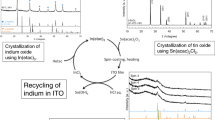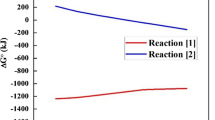Abstract
Uranium metal was successfully produced from uranium triiodide through thermal decomposition in a tetra-arc crystal furnace. The uranium triiodide was produced by reacting uranium and iodine at 600 °C for 24 h. After the uranium triiodide was heated in the arc furnace, a product was confirmed to be uranium metal through X-ray diffraction, density, and energy-dispersive X-ray spectroscopy measurements. Historically, uranium triiodide has been reduced after passing through a gaseous intermediate of uranium tetraiodide and reduced on a hot filament. This is the first report of directly reducing uranium triiodide to uranium metal, circumventing the uranium tetraiodide intermediary.







Similar content being viewed by others
References
Clark DL, Hecker SS, Jarvinen GD, Neu MP (2006) In: Morss L, Edelstein NM, Fuger J (eds) The chemistry of the actinide and transactinide elements, vol 2, 3rd edn. Springer, Berlin, p 813
Klaproth MH (1789) Chemische Untersuchung des Uranits, einer neuentdeckten metallische Substanz. Chem Ann Freunde Naturl 2:387–403
Peligot ME (1841) Recherches sur l’Urane. J Pharm 27:525–535
Harrington CD, Ruehle AE (1959) Uranium production technology. D. Van Nostrand Co., Inc., Princeton
Wilhelm HA (1960) Development of uranium metal production in America. J Chem Ed 37:56–68
Murasik A, Fischer P, Furrer A, Schmid B (1986) Magnetic phase transitions and crystal field splitting of uranium halide (UX3) compounds (X ident. chloride, bromide, iodide) investigated by neutron scattering. J Less Common Met 121:151–155
Orman S (1976) Oxidation of uranium and uranium alloys in physical metallurgy of uranium alloys. Brook Hill Pub Co., Chestnut Hill
Driggs FH, Lilliendahl WC (1930) Preparation of metal powders by electrolysis of fused salts. I. Ductile uranium. Ind Eng Chem 22:516–519
Kim S-W, Lee S-K, Kang HW, Choi E-Y, Park W, Hong S-S, Oh S-C, Hur J-M (2017) Electrochemical properties of noble metal anodes for electrolytic reduction of uranium oxide. J Radioannal Nucl Chem 311:809–814
Gibilaro M, Cassayre L, Lemoine O, Massot L, Dugne O, Malmbeck R, Chamelot P (2011) Direct electrochemical reduction of solid uranium oxide in molten fluoride salts. J Nucl Mater 414:169–173
Vishnu DSM, Sanil N, Panneerselvam G, Sudha R, Mohandas KS, Nagarajan K (2013) Mechanism of direct electrochemical reduction of solid UO2 to uranium metal in CaCl2-48 mol% NaCl melt. J Electochem Soc 160:D394–D402
van Arkel A (1943) Rein metalle. Edwards Brothers, Inc., Ann Arbor
Katz JJ, Rabinowtich E (1951) The chemistry of uranium. McGraw-Hill, New York
Prescott, Reynolds (1943) The preparation of uranium metal by the hot-wire method. Report Chem-S-206
Bagnall K, Brown D, Jones P, du Preez J (1965) Iodo complexes of thorium(IV) and uranium(IV). J Chem Soc 350–353
Brown D, Edwards J (1972) Preparation and crystallographic properties of the trichlorides, tribromides, and triiodides of uranium, neptunium, and plutonium. J Chem Soc, Dalton Trans 16:1757–1762
Evans W, Kozimor S, Ziller J, Fagin A, Bochkarev MN (2005) Facile syntheses of unsolvated UI3 and tetramethylcyclopentadienyl uranium halides. Inorg Chem 44:3993–4000
Gregory NW (1958) Preparation and properties of the uranium halides (other than the fluorides). U.S. Report TID-5290
Rudel S, Kraus F (2017) Facile syntheses of pure uranium halides: UCl4, UBr 4, and UI4. Dalton Trans 46:5835–5842
Toby B, Dreele R (2013) GSAS-II: the genesis of a modern open-source all purpose crystallography software package. J Appl Crystallogr 46:544–549
Wyckoff RWG (1963) Crystal structures. Interscience Publisher, New York
Levy J, Taylor J, Wilson P (1975) Structure of uranium(III) triiodide by neutron diffraction. Acta Crystallogr Sect B B31:880–882
Levy J, Taylor J, Waugh A (1980) Crystal structure of uranium (IV) tetraiodide by X-ray and neutron diffraction. Inorg Chem 19:672–674
Murasik A, Fischer P, Szcepaniak W (1981) Neutron diffraction study of long-range antiferromagnetic order and crystal structure of uranium(III) triiodide. J Phys C: Solid State Phys 14:1847–1854
Morss L, Edelstein N, Fuger J (2010) The chemistry of the actinide and transactinide elements. Springer, Dordrecht
Roberts L, Murray R (1955) Magnetic and thermal properties of uranium iodide at liquid-helium temperatures. Phys Rev 100:650–654
Acknowledgements
This work was performed under the auspices of the U.S. Department of Energy by Lawrence Livermore National Laboratory under Contract DE-AC52-07NA27344 and was supported by the LLNL-LDRD Program under Project No. 18-SI-001. LLNL release number LLNL-JRNL-768061.
Author information
Authors and Affiliations
Corresponding author
Additional information
Publisher's Note
Springer Nature remains neutral with regard to jurisdictional claims in published maps and institutional affiliations.
Lawrence Livermore National Laboratory: This document was prepared as an account of work sponsored by an agency of the United States government. Neither the United States government nor Lawrence Livermore National Security, LLC, nor any of their employees makes any warranty, expressed or implied, or assumes any legal liability or responsibility for the accuracy, completeness, or usefulness of any information, apparatus, product, or process disclosed, or represents that its use would not infringe privately owned rights. Reference herein to any specific commercial product, process, or service by trade name, trademark, manufacturer, or otherwise does not necessarily constitute or imply its endorsement, recommendation, or favoring by the United States government or Lawrence Livermore National Security, LLC. The views and opinions of authors expressed herein do not necessarily state or reflect those of the United States government or Lawrence Livermore National Security, LLC, and shall not be used for advertising or product endorsement purposes.
Electronic supplementary material
Below is the link to the electronic supplementary material.
Rights and permissions
About this article
Cite this article
Idell, Y.S., Holliday, K.S., Stillwell, R.L. et al. Reduction of uranium triiodide to metal by thermal decomposition. J Radioanal Nucl Chem 320, 793–800 (2019). https://doi.org/10.1007/s10967-019-06541-6
Received:
Published:
Issue Date:
DOI: https://doi.org/10.1007/s10967-019-06541-6




